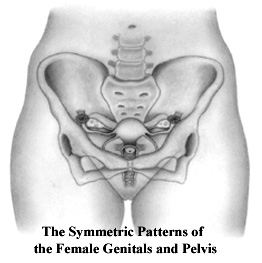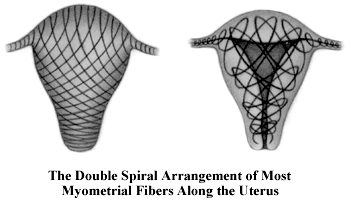



Dr. Nelson Soucasaux , Brazilian gynecologist
Let's relate gynecology to some concepts of modern science as well as to metaphysics and ancient wisdom. In my book "Os Órgãos Sexuais Femininos: Forma, Função, Símbolo e Arquétipo" ("The Female Sexual Organs: Shape, Function, Symbol and Archetype") I called attention to the existence of beautiful, perfect and very curious symmetric patterns in the woman's sexual organs. I did so because a special meaning was always attributed to symmetry, mostly in the western cultural tradition. From the metaphysical point of view, it seems to reflect some of the fundamental principles and laws of nature. Fritjof Capra observes that symmetry ". . . played an important role in Greek science, philosophy and art, where it was identified with beauty, harmony and perfection." Although observing that in the eastern philosophies the concept of symmetry does not seem to be so important as in the west, Capra remarks that ". . . the mystical traditions in the Far East frequently use symmetric patterns as symbols or as meditation devices . . . ." (Capra, F.: "The Tao of Physics," Flamingo, London, 1983.)
The main pattern of symmetry found in the female genitals and pelvis is the one known as axial symmetry. This pattern can be recognized as the longitudinal middle line of the body seen at the antero-posterior position. In women, this straight longitudinal line coincides exactly with the uterus and vagina. The way through which the myometrial smooth muscle fibers are arranged along the uterus constitutes one more very peculiar aspect of this amazing symmetry. Almost all of these muscular bundles give rise to a double spiral system of "lines of force" that symmetrically entwine around the uterine cavity. They constitute two descending spirals of smooth muscle fibers, each one of them originating in one of the Fallopian tubes, that "embrace" themselves in order to form the greatest part of the myometrium (the uterine muscular layer). Only the more external layer of the uterine musculature is basically constituted by longitudinal fibers. This anatomic and histological feature of the myometrium greatly facilitates the propagation of the contractile waves along the uterus.
 |
 |
More evidence for the curious symmetry existing in the female genitals lies in the morphology of the uterine cavity (lined by the endometrium), which is structured according to a symmetrical triangular pattern, with the main vertex directed downward - that is, an inverted triangle (see Note below). The two superior angles of this triangle correspond to the uterine openings of the Fallopian tubes, and the inferior one to the internal orifice of the cervical canal. A vast archetypal symbolism has been attributed to some triangular shapes.
The uterus has a structural organization characterized by a virtual cavity approximating the shape of a downward-pointing triangle surrounded by a double descending spiral of muscle fibers symmetrically entwined, forming a perfect system of "lines of force." The symmetry of the triangular pattern is associated with the symmetry of the "lines of force" that surround it. This triangular visceral cavity, endowed with much symbolism, is the most central one in the female pelvis. From the metaphysical point of view, these curious symmetric patterns existing not only in the uterus but also in the entire female genitalia, allied to other anatomic and functional features of these organs, may constitute one more indication of the existence of something transcendental and mysterious in women's nature.
In the eastern tantric tradition (in which women play a very special role), one of the symbols used for representing the female principle is a downward-pointing, inverted triangle. According to Philip Rawson, this female tantric triangle represents the vulva (or yoni), which, in turn, symbolizes the woman's genitals (Rawson, P., "Tantra - The Indian Cult of Ecstasy," Thames and Hudson, London, 1973). However, except for the obvious inverted triangular configuration of the female pubic hair, the vulva itself has no resemblance at all to a triangle. Probably the downward-pointing tantric triangle that symbolizes the female may rather be an unconscious representation of the uterine cavity. As these symbols date back to very ancient times when little was known of anatomy, a possible explanation for this "coincidence" may be what I call "uterine archetypes." See my article "Archetypal Aspects of the Female Genitals," published here at the MUM.
Note: Don't forget that, since the uterus is a muscular organ, obviously the shape of its cavity is not and could not be that of a geometrically perfect triangle. What really matters is the basic triangular pattern that characterizes the morphology of the uterine cavity.
P.S.: On the subject of symmetry and spiral patterns in nature, I would like to recommend the following books: 1) Lawlor, Robert: "Sacred Geometry Philosophy and Practice," Thames and Hudson, London, 1982; 2) Cook, Theodore Andrea: "The Curves of Life," Dover Publications, New York, 1979 (originally published by Constable and Company, London, 1914).
The article above is an adapted excerpt from my book "Os Órgãos Sexuais Femininos: Forma, Função, Símbolo e Arquétipo" ("The Female Sexual Organs: Shape, Function, Symbol and Archetype"), published by Imago Editora, Rio de Janeiro, 1993. For more information on the book, see page http://www.nelsonginecologia.med.br/orgaos.htm, at my Web site www.nelsonginecologia.med.br .
Copyright Nelson Soucasaux 1993, 2003 (text and illustrations)
______________________________________________________
Nelson Soucasaux is a gynecologist dedicated to clinical, preventive and psychosomatic gynecology. Graduated in 1974 by Faculdade de Medicina da Universidade Federal do Rio de Janeiro, Brazil, he is the author of several articles published in medical journals and of the books "Novas Perspectivas em Ginecologia" ("New Perspectives in Gynecology") and "Os Órgãos Sexuais Femininos: Forma, Função, Símbolo e Arquétipo" ("The Female Sexual Organs: Shape, Function, Symbol and Archetype"), published by Imago Editora, Rio de Janeiro, 1990, 1993. He has been working in his private clinic since 1975.
Website (Portuguese-English): www.nelsonginecologia.med.br
Email: nelsons@nelsonginecologia.med.br